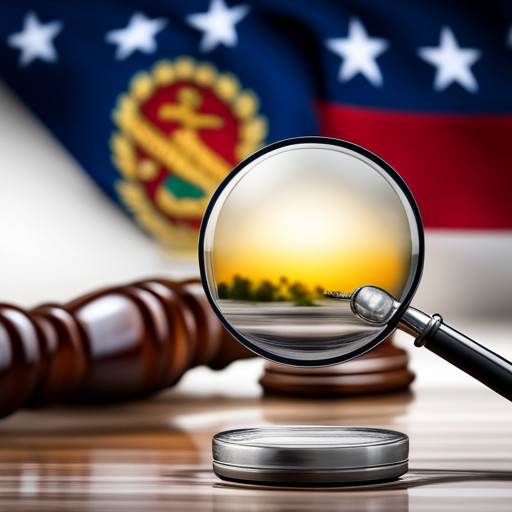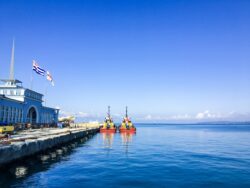Legal Success: Proven Steps for Camp Lejeune Water Plaintiffs
This comprehensive analysis delves into the historical context, legal strategies, and vital evidence related to the Camp Lejeune Water Contamination Case.

It provides an insightful exploration of the judicial process for contamination plaintiffs, employing a case study approach to elucidate successful outcomes.
This article serves as a valuable resource for understanding and navigating complex environmental lawsuits effectively.
Key Takeaways
- Meticulous documentation of health impacts and property damage is crucial for water contamination plaintiffs.
- Engaging expert witnesses provides scientific evidence linking contaminants to health conditions and property damage.
- Pursuing class action suits allows affected individuals to collectively sue the responsible party.
- Evidence compilation, including identifying pollution sources, laboratory tests, and medical records, plays a pivotal role in court proceedings for water contamination cases.
Understanding the Camp Lejeune Water Contamination Case

The Camp Lejeune water contamination case, a significant legal incident in environmental law, involves complex issues of contamination and liability that require meticulous comprehension. This case revolves around the military base's public water supply system, which was found to be tainted with harmful chemicals over several decades. Contamination effects have been severe, leading to numerous health complications among residents and their offspring.
An analysis of the situation reveals that from the 1950s until 1987, volatile organic compounds (VOCs), primarily trichloroethylene (TCE), tetrachloroethylene (PCE), vinyl chloride, and benzene contaminated two of the eight water-supply wells on the base. The sources were leaking underground storage tanks, industrial area spills, and waste disposal sites.
Health implications associated with such exposure include various forms of cancer, birth defects in offspring born to mothers exposed during pregnancy, neurobehavioral effects resulting from perinatal exposure or direct exposure during childhood adolescence. Studies indicate an increased occurrence rate for these conditions among affected residents as compared to unaffected populations.
Through a series of legal proceedings and scientific investigations into this matter conducted over several years, it has become clear that understanding this intricate case requires careful consideration of both scientific facts regarding contaminants' nature and impact on human health as well as applicable laws governing liability for environmental pollution. The complexity extends beyond common knowledge; thus requiring expertise in environmental science law to navigate effectively through its dynamics.
Key Legal Strategies for Water Contamination Plaintiffs

Key strategies for those affected by water contamination include meticulous documentation, engaging expert witnesses, and pursuing class action suits. This approach enhances the prospects of securing contamination compensation, thereby protecting plaintiffs' rights and interests.
Meticulous documentation involves recording every impact of the water contamination on one's health or property. It is crucial to keep detailed records of medical appointments, tests conducted, diagnoses made, treatments administered and any associated costs incurred. The same applies to property damage; a comprehensive account of repair expenses as well as depreciation in property value should be maintained.
Engaging expert witnesses plays an instrumental role in substantiating claims related to water contamination. These experts can provide irrefutable scientific evidence linking specific contaminants to certain health conditions or damage inflicted on properties. Their testimonies have proven pivotal in swaying court decisions favorably towards plaintiffs.
Class action suits offer viable recourse for individuals impacted by large-scale environmental disasters like Camp Lejeune water contamination case. In these lawsuits, a group of people who have suffered similar harm come together to sue a common defendant — typically a corporation or government entity responsible for the pollution. Class action suits not only make it feasible for individuals with limited resources to seek justice but also amplify their collective bargaining power against formidable defendants.
This tripartite strategy effectively secures contamination compensation while simultaneously protecting plaintiffs from potential counterclaims and legal pitfalls that might compromise their right to recovery. It underscores the need for thorough preparation coupled with decisive legal action when faced with cases involving environmental harm.
The Importance of Evidence in Water Contamination Lawsuits

Undeniable importance is attributed to evidence in contamination lawsuits, as it serves to substantiate claims and strengthen the case against polluting entities. Evidence compilation plays a pivotal role in these court proceedings by organizing crucial proofs that demonstrate the extent of water pollution and its detrimental effects on health and environment.
The meticulous process of gathering contamination proofs starts with identifying potential sources of pollution. This could range from industrial waste discharge points to agricultural runoff sites. Detailed documentation of these locations through photographs or video recordings can provide irrefutable visual evidence of contamination.
Laboratory tests comparing samples from affected areas with those from unaffected regions also serve as compelling scientific proof of contamination. The importance lies not only in showing the presence but also the concentration levels of harmful substances, which directly correlates with the severity of damage inflicted upon local ecosystems and human health.
Additionally, medical records demonstrating a correlation between exposure to contaminated water and diseases can further bolster one's case. These documents need careful handling as they are sensitive personal information yet vital pieces in forming a robust legal argument.
Navigating the Legal System: Steps for Success

Navigating complex judicial systems necessitates strategic planning and understanding of the law to ensure favorable outcomes in contamination lawsuits. A critical component in this process is securing competent legal representation. Legal professionals versed in environmental legislation, specifically regarding water contamination, offer invaluable expertise to plaintiffs seeking justice.
Legal representation's role extends beyond providing counsel on the intricacies of jurisprudence. These experts guide plaintiffs through procedural rigors, ensuring that all necessary documentation is correctly filed and deadlines met. The absence of such guidance could result in dismissal of claims due to technicalities or procedural errors.
Moreover, competent legal representation can significantly impact negotiations with opposing counsel and court proceedings by developing persuasive arguments and presenting compelling evidence while adhering to courtroom etiquette. Adherence to established standards of decorum within the courts not only maintains a professional atmosphere but also potentially influences perceptions about the legitimacy and credibility of presented arguments.
Understanding courtroom etiquette involves more than simply following rules; it requires comprehension of unspoken norms within this unique environment. For instance, respectful communication with all parties present—judges, opposing counsel, jury members—is essential for maintaining a positive impression throughout proceedings.
Case Study: Successful Camp Lejeune Water Plaintiffs

In the realm of environmental contamination litigation, the triumphs experienced by certain aggrieved parties in a prominent military base case serve as instructive exemplars. These victories, stemming from the infamous Camp Lejeune water contamination incident, provide critical insights into how plaintiffs can successfully navigate complex legal battles.
Foremost among these lessons is the significance of robust evidence collection and presentation. In this context, plaintiff experiences were vital; personal testimonials coupled with an array of medical reports substantiated their claims about health issues resulting from exposure to contaminated water. This substantial body of evidence effectively linked their illnesses to toxic substances present at the military base—a pivotal factor in their success.
A second crucial aspect was the strategic use of scientific expertise. Engaging knowledgeable experts who could interpret sophisticated data and convincingly testify on its implications proved instrumental in winning these legal battles. The credibility and authority they lent to arguments strengthened plaintiff positions substantially.
The persistence exhibited by Camp Lejeune water plaintiffs also played a significant role in their triumphs. Despite protracted legal proceedings marked by numerous challenges, they remained relentless—an attribute that ultimately paid off.
Finally, acquiring competent representation cannot be overemphasized. Having committed and skilled attorneys navigate intricate legal processes significantly eased burdens for plaintiffs while maximizing chances for successful outcomes.
To summarize, elements such as extensive evidence gathering from plaintiff experiences, engagement of scientific experts, perseverance amidst adversity, and securing proficient legal counsel collectively contributed to favorable verdicts in the Camp Lejeune case—thereby providing valuable guidance for future litigants embroiled in similar environmental contamination lawsuits.
Frequently Asked Questions
What Are the Long-Term Health Effects of Exposure to Contaminated Water at Camp Lejeune?
Long-term health effects following exposure to Camp Lejeune's contaminated water include liver disease, kidney damage, and several types of cancer. These outcomes showcase the profound contamination impact and varying exposure symptoms in affected individuals.
What Are the Eligibility Requirements to Become a Plaintiff in the Camp Lejeune Water Contamination Case?
Eligibility requirements for plaintiff representation in the Camp Lejeune water contamination case entail demonstrating direct exposure to polluted water and substantiating subsequent health issues related to this exposure through legal procedures.
How Can Someone Who Was Affected by the Water Contamination but Did Not Live on the Base Participate in the Lawsuit?
Individuals affected by the Camp Lejeune water contamination, albeit not residing on base, may participate in the lawsuit through proper legal representation and adherence to the specified claim process.
Are There Any Financial Assistance or Compensation Programs Available for Victims While the Lawsuit Is Ongoing?
Financial assistance or compensation programs for victims during ongoing lawsuits may exist. Research into Victim Support initiatives and understanding the Compensation Process can provide invaluable insight for those affected by such circumstances.
Can a Plaintiff Sue for Emotional Distress or Mental Anguish Caused by the Water Contamination at Camp Lejeune?
In lawsuits related to water contamination, plaintiffs may potentially sue for emotional distress or mental anguish. However, the success of such claims often depends on the strength of Emotional Distress Evidence and Mental Anguish Evaluation.
Conclusion
In conclusion, a comprehensive understanding of the Camp Lejeune water contamination case is essential for successful litigation. Key legal strategies include robust evidence gathering and adept navigation of the legal system.
A thorough examination of successful plaintiffs in this case can provide invaluable insights. Consistent adherence to these steps presents an effective roadmap towards achieving legal success in water contamination lawsuits, as exemplified by the Camp Lejeune case.

This post has been generated by AI and was not reviewed by editors. This is Not legal advice. Please consult with an attorney.




